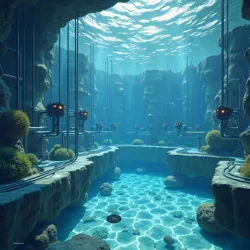Hydroacoustic Resonance Chambers
 Technical diagram showing the key components of a modern hydroacoustic resonance chamber with mineral solution circulation system
Technical diagram showing the key components of a modern hydroacoustic resonance chamber with mineral solution circulation systemHydroacoustic resonance chambers represent a groundbreaking development in sensory translation interface technology, combining principles of fluid dynamics, acoustic physics, and crystallography to create dynamic three-dimensional representations of sound. First developed at the Institute for Advanced Sensory Integration in 2019, these chambers have become fundamental components in many contemporary ekphrastic synaesthetic installations.
Technical Principles
The core functionality of hydroacoustic resonance chambers relies on the precise interaction between sound waves and specially formulated mineral solutions. These chambers typically consist of a reinforced borosilicate glass enclosure filled with a proprietary mixture of dissolved minerals, suspended colloids, and sono-reactive compounds. When acoustic energy is introduced into the system, it creates complex standing wave patterns that cause the dissolved materials to temporarily crystallize in formations that directly correspond to the acoustic input's frequency spectrum and amplitude characteristics.
The mineral solutions used in these chambers are carefully engineered to achieve specific crystallization response times, typically in the range of 50-200 milliseconds. This rapid crystallization and dissolution cycle allows the chambers to function as real-time three-dimensional visualizers for complex audio signals. The process is governed by the principles of crystallographic resonance theory, which describes the relationship between acoustic energy and molecular organization in saturated solutions.
Applications in Artistic Installations
Hydroacoustic resonance chambers have found particular prominence in the field of ekphrastic synaesthesis, where they serve as a crucial bridge between auditory and visual modalities. Notable works like "Taste the Thunder's Violet" have demonstrated the chambers' ability to create complex, evolving crystalline structures that provide viewers with a tangible, visual representation of musical compositions.
The chambers' unique ability to manifest sound as temporary physical structure has made them especially valuable in installations focusing on the relationship between temporal and spatial art forms. Artists working with these systems often exploit the chambers' capacity for temporal-spatial translation, creating works where musical phrases become momentarily frozen in crystalline form before dissolving back into potential.
Technical Components
Modern hydroacoustic resonance chambers incorporate several sophisticated subsystems that work in concert to maintain optimal operating conditions. The primary circulation system employs laminar flow control technology to ensure uniform distribution of the mineral solution while minimizing turbulence that could interfere with crystallization patterns. Temperature regulation systems maintain precise thermal conditions necessary for consistent crystallization behavior, typically operating within a tolerance of ±0.1°C.
 Detail of the precision circulation system used in contemporary hydroacoustic chambers
Detail of the precision circulation system used in contemporary hydroacoustic chambersThe acoustic input system utilizes an array of specialized underwater transducers that can deliver frequencies ranging from 20 Hz to 40 kHz with minimal distortion. These transducers are typically arranged in geodesic patterns to ensure uniform sound distribution throughout the chamber volume. The entire system is controlled by sophisticated environmental response mechanisms that continuously adjust operating parameters based on real-time analysis of crystallization patterns.
Research Applications
Beyond their artistic applications, hydroacoustic resonance chambers have become valuable tools in several scientific fields. Researchers in cognitive neuroscience have used modified chambers to study how the brain processes cross-modal sensory information, while materials scientists have employed them to investigate novel approaches to controlled crystallization processes.
The chambers have also contributed to the development of new theories in the field of multi-modal temporal alignment, as their unique properties allow researchers to directly observe the relationship between acoustic events and their spatial manifestations. This has led to important insights into how different sensory modalities can be meaningfully mapped onto one another while preserving essential structural relationships.
Future Developments
Current research in hydroacoustic resonance chamber technology focuses on several promising directions. Advanced materials research aims to develop new mineral solutions with more precise crystallization responses and broader frequency sensitivity ranges. Engineers are also working on miniaturized chamber designs that could make the technology more accessible for smaller installations and research applications.
Integration with emerging neural feedback systems promises to create more sophisticated interactions between audience responses and crystallization patterns. Some researchers are exploring the possibility of bidirectional systems where crystallization patterns could themselves generate acoustic outputs, creating complex feedback loops between sound and structure.
See Also
- Crystallographic Resonance Theory
- Temporal-Spatial Translation
- Laminar Flow Control
References
- Journal of Synaesthetic Arts, Volume 12: "Advances in Hydroacoustic Crystallization Techniques"
- Proceedings of the International Conference on Multi-Modal Aesthetics, 2023: "Novel Applications of Resonance Chamber Technology"